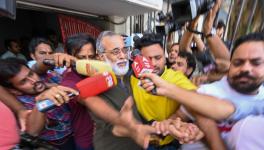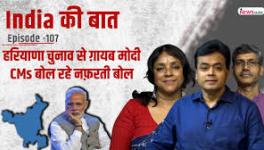Disputed Structure Ki Baat: Why PM Shouldn’t Call it Ramjanmabhoomi

Is Prime Minister Narendra Modi subtly preparing his party’s cadre and that of Sangh Parivar affiliates for a Supreme Court verdict which is not completely in favour of Hindu parties in the Ayodhya case?
Or, did he convey a message to Muslim parties that they should accept the judgement even if they are denied ownership of one-third of the disputed land awarded by the Allahabad High Court in 2010, because the disputed site in Ayodhya is, in his opinion, nothing but “Ramjanmabhoomi”?
Politically-noteworthy statements made by Modi in the latest episode of his monthly radio talk, Mann Ki Baat, aired on October 27, the day of Diwali festival, recalled the response of “government, political parties, social organisations, civil society, representatives of all sects and saints” in the aftermath of the Allahabad High Court verdict of September 30, 2010.
This radio talk was significant, since so far Modi has ostensibly kept political subjects out of his bid to establish ‘human contact’ with people through his one-way radio interaction.
The radio show has been modelled on former United States president Franklin Delano Roosevelt’s Fireside Chat, a format which enabled him to broadcast his persona into the cosy and intimate precincts of people’s homes.
For Modi, however, Mann Ki Baat is important because it soon became a vehicle to circumvent established media channels. Besides, for the show, he picks and chooses his own subjects and delivers a monologue on them.
Modi called the reaction of various parties that he listed as “restrained and balanced” and held this up as the example to follow. The Prime Minister’s intervention on what is a totally politically matter, one which has shaped Indian polity for three decades, is extremely significant, for the apex court’s verdict is expected any day within the next fortnight.
The Chief Justice of India, Rajan Gogoi, is due to retire on November 17, and if the judgement is not delivered by then, the entire hearing will likely be necessary all over again, as a new judge would be nominated to replace him and fill the vacancy of the fifth judge.
Because the address was broadcast on one of the most important Hindu festivals, when most people have little time and interest in daily news and current events, the significance of Modi’s assertions are yet to dawn. Yet, his intervention is possibly the most significant made by the Prime Minister on the subject after he assumed office, and that too so close to the Supreme Court verdict.
There are two parts of Modi's comments on Ayodhya. The first and most striking is his choice of words when referring to the disputed shrine. He called the High Court judgement a ruling on “Ramjanmabhoomi” and not “disputed site”, as a person in his position should refer to the contentious 2.77 acres of land prior to the apex court’s verdict.
After all, besides being a simple civil title suit, in the case which has dragged on for decades matters ranging from faith to tradition are factors.
At a time when every aspect of the dispute is being judicially examined, it was improper for the Prime Minister to declare it the Ramjanmabhoomi. In the process, he has made his political alignment on the matter so clear. Undoubtedly, Modi has failed as the country’s chief executive and has held truer to his political viewpoint.
Every previous Prime Minister who has held the office from the time when the Ayodhya dispute began playing a pivotal role in Indian politics, has referred to the shrine demolished on December 6, 1992, and the land involved in the case as a “disputed” structure or land. This includes the Bharatiya Janata Party’s (BJP’s) very own, former Prime Minister Atal Bihari Vajpayee. Video clips abound in the public domain that confirm such depiction.
Yet, Modi has chosen to term the place Ramjanmabhoomi, which makes his own intention clear and also shows how he would prefer others, including the judiciary, to refer to it.
Modi also recalled how in the period preceding the High Court judgement of 2010 there was palpable tension in the country: “The kind of language that was spoken in order to generate tension in the atmosphere!” He added that several “of the loudmouths and the braggarts had the sole intention of hogging the spotlight at that time. And we all know what kind of irresponsible talk was floating around.”
At no point does Modi concede that the most vituperative comments on Ayodhya since the mid-1980s, when the agitation was patronised by the Sangh Parivar constituents, were made by leaders and cadre from within the saffron fold.
After calling the property under dispute the birthplace of the Hindu god, Rama, Modi’s allegations against “unnamed people” is akin to the FIRs filed by police against ‘unknown persons’—everyone knows who the accusations are against, except the police!
In this case, it is evident which parties or community Modi is accusing of “attempts to instil shrillness” in the political discourse—the Muslims.
Despite Modi’s positioning, there is no certainty about the verdict which the five judges of the Supreme Court are likely to deliver. This is why Modi has also prepared his cadre for a not completely favourable judgement.
It is pertinent to recall that the High Court judgement was termed a “please-all” or “panchayati faisla” because it divided the disputed property between the Uttar Pradesh Sunni Waqf Board, the Nirmohi Akhara and Ram Lalla Virajman. It cannot be ruled out that after almost a decade-long wait, the apex court may just uphold the previous judgement.
This explains why Modi recalled “attempts to reduce the tension in the socio-political environment” in his radio address on Diwali. Although there are several occasions in his political career when he has been on the other side of the judiciary, the Prime Minister claimed he was “happy that the dignity of the judiciary was very proudly honoured”.
Modi also said that the responses to the High Court judgement in the weeks following it “should always be remembered as they impart us a lot of strength.”
Although his assertions make it evident what verdict he and his colleagues are hoping for, he appears to be asking supporters to rein their anger in the event of the judgement not being in favour of the Hindu parties.
For once, Modi is in the not-so-enviable position of drumming up support for a majoritarian cause while being responsible for maintaining law and order in the wake of the Supreme Court verdict.
Nilanjan Mukhopadhyay is a senior Delhi-based journalist and author. He wrote The Demolition: India At The Crossroads after the destruction of Babri Masjid. His most recent book is The RSS: Icons of The Indian Right. The views are personal.
Get the latest reports & analysis with people's perspective on Protests, movements & deep analytical videos, discussions of the current affairs in your Telegram app. Subscribe to NewsClick's Telegram channel & get Real-Time updates on stories, as they get published on our website.
























